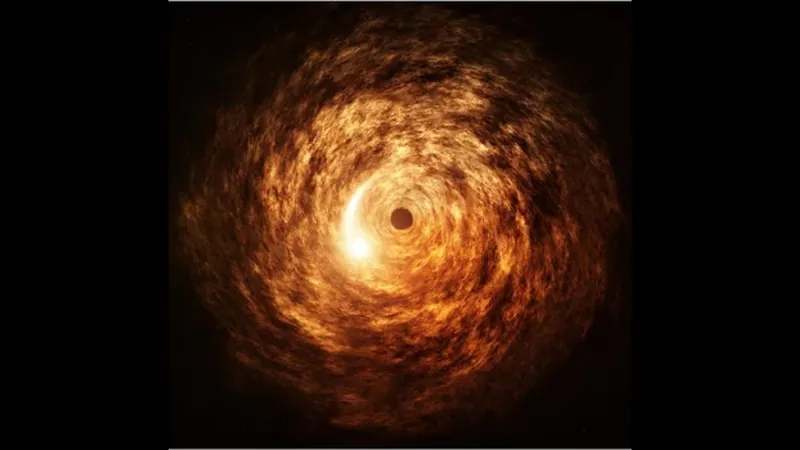
James Webb Telescope Makes Groundbreaking Discovery: First 'Mid-Infrared' Flare from Supermassive Black Hole in Milky Way
2025-01-17
Author: Rajesh
Discovery Overview
In an exciting breakthrough for astrophysics, the James Webb Space Telescope (JWST) has successfully detected a mid-infrared flare emanating from Sagittarius A*, the supermassive black hole situated at the center of our Milky Way galaxy. This groundbreaking observation is expected to unravel the mystery behind the phenomenon of these high-energy outbursts.
Sagittarius A* Characteristics
Sagittarius A* holds a staggering mass approximately 4 million times that of our Sun and is located a remarkable 26,000 light-years away from Earth. Surrounding this colossal black hole is a swirling disk of gas and dust that regularly emits flares, intense bursts of light believed to be triggered by disturbances in magnetic fields. Researchers from the Max Planck Institute for Radio Astronomy in Germany theorize that these flares occur when magnetic field lines intersect, resulting in the release of significant amounts of energy. The energized electrons travel along these connected lines at nearly the speed of light, emitting high-energy radiation photons—particles of light—in the process.
Mid-Infrared Emission Discovery
Interestingly, while astronomers had previously observed these flares in short-wave visible light and long-wave radio signals, the exciting aspect of the JWST's recent findings is the detection of these emissions in the mid-infrared spectrum—a region characterized by the heat we feel but cannot see. Joseph Michail, a co-lead author of the study and a researcher at the Harvard Center for Astrophysics stated, “For over 20 years, we've known what happens in the radio and what happens in the near infrared, but the connection between them was never 100% clear or certain. This new observation in mid-infrared fills in that gap and connects the two.”
Significance of the Observation
The James Webb Space Telescope, which orbits the sun nearly a million miles (1.5 million kilometers) from Earth, has been revealing the universe's secrets since its launch in 2021. On April 6, 2024, it tracked the remarkable 40-minute flare from Sagittarius A*, providing pivotal data that supports existing simulations about the mechanisms driving these energetic bursts.
Correlation and Synchrotron Emission
Researchers observed a correlation between the variations observed in short-wavelength measurements and the mid-infrared data, suggesting that the rapid movement of electrons is indeed responsible for ejecting photons along magnetic field lines—a phenomenon known as synchrotron emission.
Implications of Research
Sebastiano von Fellenberg, another co-lead author of the study, emphasized the implications of this discovery: “While our observations suggest that Sgr A*'s mid-infrared emission results from synchrotron emission from cooling electrons, there's more to understand about magnetic reconnection and the turbulence in Sgr A*'s accretion disk. This first-ever mid-infrared detection, combined with the variability noted with the Submillimeter Array, not only fills a gap in our understanding of the flare’s origin but also opens up new avenues for vital research.”
Conclusion and Future Research
This groundbreaking achievement by JWST marks a significant leap forward in our understanding of the dynamics surrounding supermassive black holes and their influence on galactic evolution. As astronomers continue to analyze the data, the insights gained from this mid-infrared observation will likely reshape our understanding of cosmic phenomena and the universe as a whole. Stay tuned for more astonishing developments from the James Webb Space Telescope!




 Brasil (PT)
Brasil (PT)
 Canada (EN)
Canada (EN)
 Chile (ES)
Chile (ES)
 Česko (CS)
Česko (CS)
 대한민국 (KO)
대한민국 (KO)
 España (ES)
España (ES)
 France (FR)
France (FR)
 Hong Kong (EN)
Hong Kong (EN)
 Italia (IT)
Italia (IT)
 日本 (JA)
日本 (JA)
 Magyarország (HU)
Magyarország (HU)
 Norge (NO)
Norge (NO)
 Polska (PL)
Polska (PL)
 Schweiz (DE)
Schweiz (DE)
 Singapore (EN)
Singapore (EN)
 Sverige (SV)
Sverige (SV)
 Suomi (FI)
Suomi (FI)
 Türkiye (TR)
Türkiye (TR)